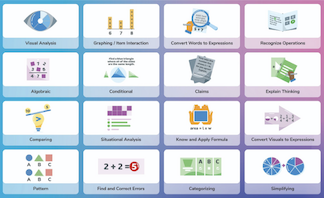
8th Grade Math - SP.A.3 and SP.A.4 - Analyzing Bivariate Data
11 Questions
Analyzing Bivariate Data Introduction
The table below represents the amount of 11th and 12th graders at Flintwick High School who are taking 0 period classes or 7th period classes.
Part 1: The plot shown describes the relationship between students' scores on the first quiz in a class and their corresponding scores on the second quiz in the class.
Part 2: Based on this line of best fit, estimate the score on the second exam for a student whose first exam score was 10.
This scatter plot shows the relationship between the number of swimsuits sold and the temperature outside.
This scatter plot shows the relationship between the number of grams of protein and the number of calories in various snack bars found in the grocery store.
Kyla conducted a survey about which fictional universe people would most like to live in. What statements about this data are true? Select ALL that apply.
Match each line of best fit to the equation that best approximates it.
Part 1: Teachers at Johnston Elementary wanted to know if cell phone ownership increased between the grade levels. Their unfinished table is shown below.
Part 2: Teachers at Johnston Elementary wanted to know if cell phone ownership increased between the grade levels. Their unfinished table is shown below.
A teacher asked each of her 30 students if they have a computer. She also asked them if they have a cell phone. The Venn diagram below shows the data she collected.

We help districts in California boost CAASPP Math Scores by Δ +20% by helping teachers determine if students are struggling with the content, the technology involved with the type of question, or the type of strategic thinking required. Based on the 8 Standards for Mathematical Practice, our platform and professional development empowers teachers to recognize all 16 types of strategic thinking across any math question, curriculum, or assessment.
Learn more